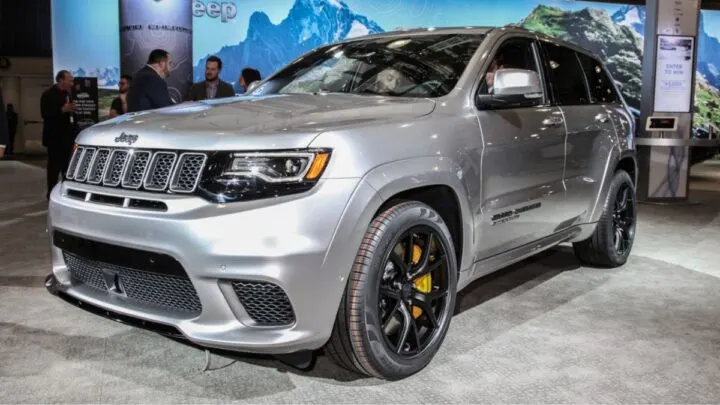When choosing between the Jeep Cherokee and Grand Cherokee, it can be tough to decide which one is right for you.
There are a few key differences to consider.
Not considering the equipment and features within the Grand Cherokee and Cherokee can make searching for a vehicle confusing.
The names are rather close to one another, but the vehicles certainly offer unique amenities.
The Jeep Grand Cherokee and Cherokee’s differences come mostly from the overall cargo space and engine options. Off-road drivers will also notice an improvement in ground clearance with the Grand Cherokee.
The two vehicles offer similar technology abilities. Car manufacturers like Jeep make completely different vehicles for different wants and needs.
We’ll explore the actual differences between the Grand Cherokee and the Cherokee. This includes key features offered for both vehicles and how the vehicles have changed over the years.
We’ll use information directly from Jeep and their details about the Grand Cherokee and the Cherokee.
We’ve done both car shopping and car selling and a bit of off-roading, which both vehicles are known for.
Size Difference
Amongst the reasons why the Jeep Grand Cherokee earned the name “Grand” is because the whole vehicle is a bit bigger than the Cherokee.
In-vehicle industry terms, the two vehicles are actually in different categories. The Grand Cherokee is a mid-size SUV, and the Cherokee is a small crossover SUV.
Drivers will notice a bit more room in the front seat, but the key differences between the Grand Cherokee and the Cherokee are more significant in the back and trunk.

Trunk Space
In 2019 and more recent Grand Cherokees, you get 36.3 cubic feet of space behind the 2nd row before folding the 2nd row down.
The Cherokee has a smaller capacity of about 25.8 cubic feet.
Drivers who don’t particularly need the additional storage space might opt for the Cherokee, but people who travel frequently or carry more cargo might prefer it.
With the seats folded down, the differences get even bigger. The Grand Cherokee offers 68.3 cubic feet of total capacity, while the Cherokee has 54.7 cubic feet.
Interior Differences
There are some subtle and not-so-subtle differences in features you can get between the Grand Cherokee and the Cherokee.
Both the Cherokee and the Grand Cherokee are available with cloth or leather sets, depending on the trim level you choose.
The key differences here are in comfort and amenities. The Cherokee offers heated seats, which is nice for cold climates, but the Grand Cherokee has available ventilated and heated seats.
Drivers who live in very hot climates will enjoy moving cool air that removes the heat in a way that air conditioning can’t.
Second-row passengers can enjoy heated seats in the Grand Cherokee while the Cherokee doesn’t offer the option.
The Grand Cherokee also adds steering wheel radio controls while the option is not on the Cherokee.
Technology Differences
Both the Grand Cherokee and Cherokee in recent model years have the capability of using Android Auto and Apple CarPlay.
The Cherokee does offer the ability to add Rear Cross Path Detection and Blind Spot Monitoring, while the Grand Cherokee adds more advanced features like the ParkView Backup Camera and LaneSense Lane Departure Warning.
LaneSense is an excellent safety option in case you get tired or distracted and leave your lane without signaling.
The Grand Cherokee includes a larger 8.4” screen, while the lowest Cherokee trim levels offer a 7” screen.
Both the Cherokee and the Grand Cherokee have navigation, though Android Auto and Apple CarPlay can show navigation in your vehicle from your phone.
Drivers who want more advanced safety features might opt for the Grand Cherokee, but the Cherokee does well in this category too.
Engine and Performance Differences
The engine is where you see even bigger differences between the Grand Cherokee and the Cherokee!
The most recent generation of Jeeps has the Cherokee offering three engines: a 2.4-liter Tigershark engine capable of 180hp, a 3.2-liter 6-cylinder engine capable at 271hp, and finally a 2.0-liter turbocharged engine with the same horsepower as the 6-cylinder.
The turbocharged engine gets the best gas mileage of all by one mile per gallon.
The Grand Cherokee gives more options. The turbocharged engine is gone, but the Grand Cherokee starts at the 3.6-liter 6-cylinder engine at 295hp.
Drivers who want more power can choose from three different 8-cylinder engines, including a 5.7-liter, 6.4-liter, and turbocharged 6.2-liter. The 6.2 -liter gives big performance with up to 707hp.
You’ll get less gas mileage in the Grand Cherokee, with 19/26 at best, but drivers who want more acceleration might find it worthwhile.
Note that part of the increased engine size comes from having a larger vehicle too.
Off-Road Performance Differences
Drivers who want to take their Jeep off the road will see some unique amenities in the Grand Cherokee.
Ground clearance is important to off-roaders who want some extra space between their vehicle and rocks, mud, water, and uneven roads.
More ground clearance can prevent the likelihood of getting stuck or otherwise damaging the underside of the vehicle.
The Grand Cherokee has 10.8 inches of ground clearance, which is more than the average SUV. The Cherokee offers a still capable 8.7 inches, which still is good for an SUV.
The more significant differences in off-roading actually depend more on the trim level and options you pick for your Cherokee or Grand Cherokee.
Both have Trailhawk and other off-road trims that offer multiple drive modes that are helpful when driving on sand, rocks, and other roads that aren’t your everyday pavement.

Exterior Differences
You’ll notice a couple of significant changes in both style and function within the Cherokee and the Grand Cherokee’s exterior.
The Grand Cherokee will be a bit longer to support the extra cargo space and larger engine.
While the Cherokee is offered with 17”, 18” or 19” wheels, the Grand Cherokee starts at 20”, making the vehicle appear taller.
Grand Cherokee drivers who are out at night might also appreciate the addition of Bi-Xenon HID headlights – through the Cherokee’s LED headlights are certainly bright and clear too.
Trim Differences
Another key difference between the Grand Cherokee and the Cherokee.
The Cherokee has five trim levels that offer a variety of amenities, including a touch screen ranging from 7 to 8.4 inches.
The Grand Cherokee adds 3 trim levels for a total of 8, including the performance-oriented SRT, as well as Overland and Summit.
These vehicle trims are meant to make the Cherokee and the Grand Cherokee more distinct. The purpose of the multiple trim levels is to offer Jeep drivers a big variety of luxury amenities, as well as exterior abilities.
Price Differences
In the world of SUVs, you might expect a bigger, more loaded-up vehicle to cost more. This statement is definitely correct about the Grand Cherokee and the Cherokee.
The current starting MSRP for a Cherokee is $26,555, while the Grand Cherokee starting MSRP is $34,000.
The price difference might make some take a look at the Cherokee first to see if they need the extra space, engine power, and off-road capability.
Which Should You Pick? Final Remarks on Grand Cherokees vs. Cherokees
The answer depends on your budget and wants. If you aren’t in need of extra space and are concerned about gas mileage, jump on board with the Cherokee.
If more serious power and space are important, the Grand Cherokee is right up your alley. Both vehicles are capable of off-road machines with a ground clearance advantage over the Grand Cherokee.
If you also need more space for the family vacation, the Grand Cherokee is where you want to invest.
If you found this article helpful, make sure to take a look at some of my other related articles below!
